Application
performance
To test the processors performance during
data archiving we resort to WinRAR archiving utility. Using maximum compression
rate we archive a folder with a lot of files with 1.1GB of storage.
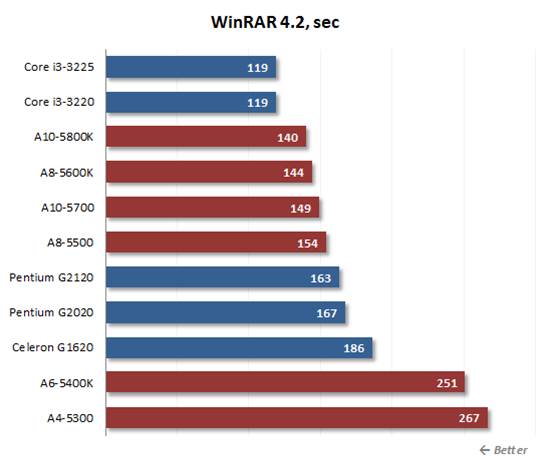
WinRAR
archive using maximum compression rate
The latest WinRAR runs fine on the
multi-core processors, but quad-core Trinity APU is somewhat slower than the
dual-core Core i3 CPUs that support Hyper-Threading. On the other hand, A10 and
A8 series are much faster than the Pentium and Celeron CPUs which are being
ahead of the AMD's A4 and A6 in terms of data compression speed.
To test audio transcoding performance, we
use the Nero AAC Encoder 1.5.1.0 to convert a grabbed CD into the AAC format.
This encoder (like the majority of tools for converting audio files) generates
single-threaded load only.
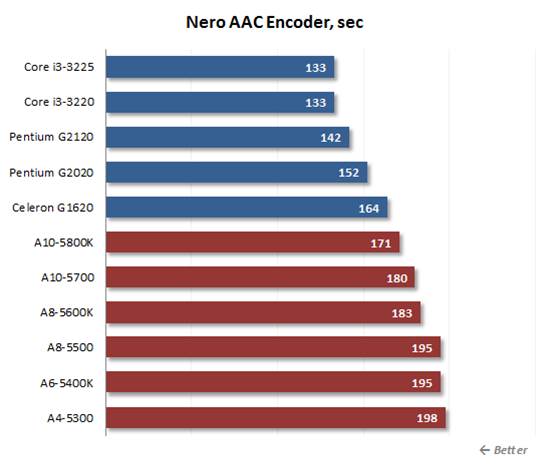
Check
out audio transcoding performance using Nero AAC Encoder 1.5.1.0
Piledriver microarchitecture used in modern
AMD processors cannot provide competitive single-threaded performance. Intel's
solution is faster for such loads. As you can see, encoding audio goes faster
on the dual-core Celeron than on the quad-core A10 which is 50% faster in terms
of clock rate and 50% more expensive to the bargain.
Web application performance was benchmarked
using RoboHornet, a browser test that makes use of all modern
resource-consuming web technologies. This test was run on Google Chrome 24.
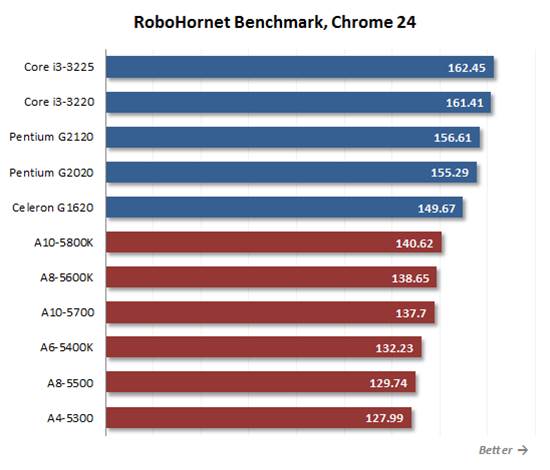
Web
application performance was benchmarked using RoboHornet
Current web browsers are known to support
multi-core CPUs but only formally. For example, even though each Chrome tab is
processed as a separate instruction thread, the web application or page in the
forefront will only use one CPU core. Trinity series can not be expected to
offer high performance under such conditions, so Ivy Bridge processors crunch
through the single-threaded load much faster.
We benchmark CPUs in Adobe Photoshop CS6
with custom test based on the Retouch Artists Photoshop Speed Test, and
consists of typical processing of four 24-megapixel images captured with a
digital camera.

Benchmarking
CPU in Adobe Photoshop CS6 CPU with custom test
AMD's hybrid APU also can not show off its
high performance in Adobe Photoshop, even this well-known photo editing
applications usually create multi-threaded loads. Again, we see that the
fastest processor for Socket FM2 platform is slower than the Celeron G1620, one
of the junior products of the LGA1155 platform based on the microarchitecture
iv.
In order to measure how fast our testing
participants can transcode a video into H.264 format we used x264 FHD Benchmark
1.0.1 (64 bit). It works with an original MPEG-4/AVC video, recorded in
1920x1080 @ 50fps resolution with 30 Mbps bitrate.I have to say that the
results of this test are great practical value, because the x264 code is also
very much a part of popular transcoding utilities, such as HandBrake, MEGui,
VirtualDub, ...
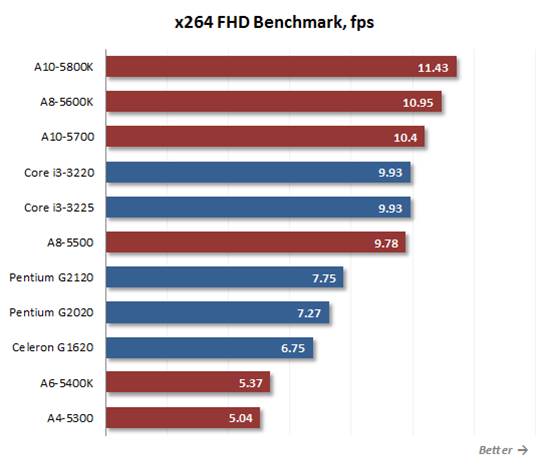
Measuring
how fast our testing participants can transcode a video into H.264 format
Video transcoding is one of the few
scenarios where Piledriver microarchitecture can be the best. AMD's quad-core
solutions are ahead of the Core i3 this time, about 15%, if we compare the
flag-ship A10-5800K with the similarly priced Core i3-3220. Trinity dual-core
modifications do not share their success with their quad-core brothers, lagging
behind both the Pentium and Celeron.
We use special Cinebench 11.5 benchmark to
test final rendering speed in Maxon Cinema 4D suite.
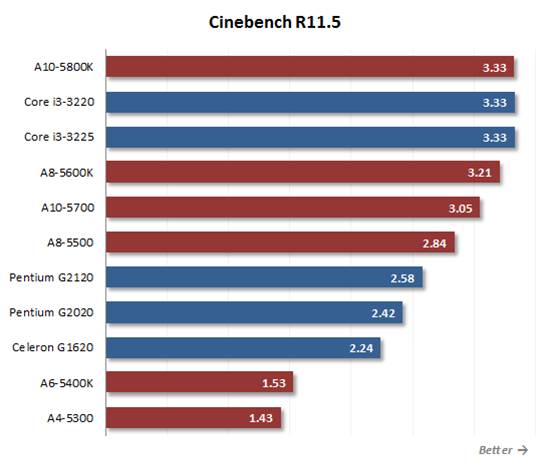
Using
special Cinebench 11.5 benchmark to test rendering speed
Rendering is another types of
multi-threaded computing load which is mostly done on the CPU’s integer
subunits. It is in such situations that the senior Trinity modifications can
challenge the Core i3 series. However, they do not have any significant
advantages at this point even under such favorable conditions. The senior APU
A10 series are just as fast as the junior members of the Core i3 series. The
APU A8 series are somewhere between Core i3 and Pentium serires, just like in
the other tests.
The next diagram shows one of the
intermediate results of the Futuremark 3DMark11 benchmark – Physics Score. This
score shows how fast the testing participants can cope with a special physics
test - emulating the behavior of a complex system with a large number of
objects.
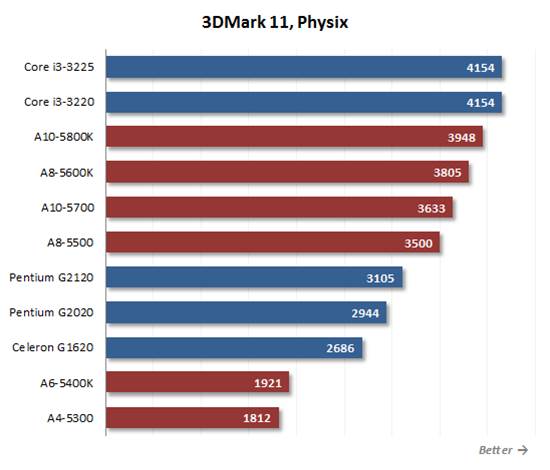
The
intermediate results of the Futuremark 3DMark11 benchmark – Physics Score
Although this load can be easily
distributed on the multi-core processors, the AMD A10 and A8 processors with
twice the number of x86 cores available in their Intel opponents cannot show a
high result. The weakness of the Trinity design is that each dual-core
Piledriver module contains only one floating-point subunit which are required
for physics processing. That's why the Core i3 series are faster than quad-core
processors of the Socket FM2 platform while the dual core A4 and A6 APUs are
inferior in terms of speed with the modern model from the Pentium and Celeron
series.